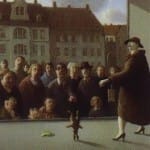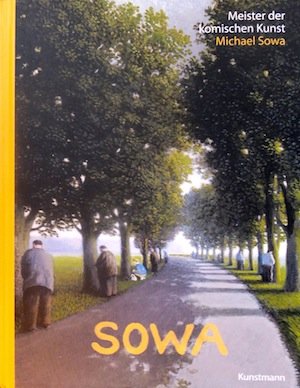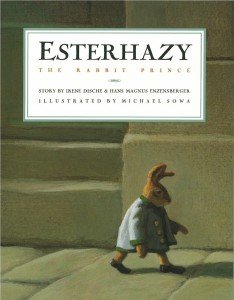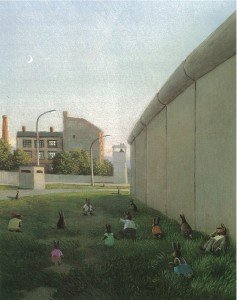When I was in Newcastle in 1993, I encountered the art of Michael Sowa for the first time in the card section of a local shop. The card was a reproduction of an image from Esterhazy: The Rabbit Prince, but I was unaware of this fact. It was simply a picture of a rabbit in front of a mirror in black and yellow leopard skin boxer shorts, several sizes too big. The illustration was completely charming, so I picked it up, and all of the other cards by this artist. Soon after I got back to Canada, Esterhazy hit the bookstore shelves, and I fell in love. And now, 17 years later, I am happy to report Michael Sowa has not left me, or disappointed me, or broken my heart in any way. On the contrary, my love has only deepened. He is, and I say this without any equivocation, my favourite artist.
Michael Sowa was born in Germany in 1945 and studied at the Academy of Fine Arts in Berlin. There is little biographical information about him, but his art is everywhere…in books, cards, prints and even movies, including two Oscar nominated shorts: Grisen (the Pig) in 2008 and most recently, the Polish documentary Rabbit à la Berlin (Krolik po Berlinsku) in 2009.
Most famously, Sowa’s art (and pig lamp) can be seen in the French film, Amélie (2001), which may be the origin of his current popularity. It’s hard to explain otherwise. Only a few of his books have been translated into English, and most, if not all are out of print, including Esterhazy.
His lordship Michael Paul Anton Maria, Prince Esterhazy the 12,792nd of Bunnimore and Burrow of Austria, Earl of Snack, Count of Cucumbria, Cabbage Head and Leekfielt, Commander of Welsh Rabbits, or Esterhazy for short, is from an aristocratic, but diminutive family of rabbits in Austria. In an effort to increase the size of the oft-ridiculed family, the grandfather decides to send his grandchildren abroad, to marry ‘very big rabbits, and then their children will be just the right size.’
Esterhazy is sent to Berlin, at a time when Germany is still divided between East and West. Ultimately, his destiny will hinge on the fall of the Berlin wall, but before actual historical events intersect with Esterhazy’s story, he meets Bonny, a big, dark-eyed bunny sitting in basket in a window. Esterhazy is invited to join her, and a few days later, just as he is about to declare his love, he is sold to a man and his obnoxious daughter, Eva. Poor Esterhazy is forced to take baths, live in a wooden box, and endure unwelcome bunny-handling by ‘Eva’s horrible friends.’
Eventually he escapes and makes his way back to Berlin, where he finds a job entertaining shoppers in yet another window. (When your name is Easter Bunny, the job opportunities are limited. Just ask Lady Gaga.)
However, once Easter is over, Esterhazy is unceremoniously kicked to the curb. Ever resourceful, he finds Bonny living with a group of rabbits in no-man’s land on the eastern side of the Berlin wall, days before it tumbles around them.
The two rabbits escape to the country, where they have medium-sized children, thus fufilling Grandpa Esterhazy’s little experiment in genetic engineering.
The story, written by Irene Dische and Hans Magnus Enzensberger, is quite wonderful, and a perfect venue for the peculiar imagination of Michael Sowa. His paintings, done in acrylic and gouache, are often very amusing, but also deeply nuanced. Even in that first card, with Esterhazy standing in front of a mirror in big-boy boxer shorts, there is something wistful about the image. Perhaps it’s the sombre background, which evokes, and I think intentionally so, the art of Caspar David Friedrich, the great German Romanticist.
Like Friedrich, Sowa injects his paintings with a level of emotional intensity that can be both moving and unsettling, but unlike Friedrich, Sowa paints with a twinkle in his eye. It’s clear that Sowa has profound understanding of human (and bunny) vulnerability, but he never fails to find the humour in our creature interactions. And with such exceptional skills as a painter, it seems almost too much that he should also be so damn funny. But there it is.
As mentioned, Michael Sowa’s books can be hard to find, but along with Esterhazy, I would highly recommend Sowa’s Ark, a collection of his art up to 1996. If Esterhazy hasn’t won you over, this one will. If you really wanna hurt yourself, have a stroll through Amazon Germany. It only takes a few minutes to realize that we’ve only seen the tip of the Sowa iceberg. Bring on the translators!
 Esterhazy: The Rabbit Prince (Creative Editions, 1993), written by Irene Dische and Hans Magnus Enzensberger, illustrated by Michael Sowa
Esterhazy: The Rabbit Prince (Creative Editions, 1993), written by Irene Dische and Hans Magnus Enzensberger, illustrated by Michael Sowa
Sowa’s Ark: And Enchanted Bestiary (Chronical Books, 1996) foreward by Nick Bantock, Illustrations by Michael Sowa
LITTLE KING DECEMBER (CLICK ON THE LINK FOR A FULL REVIEW) by Axel Hacke, illustrations by Michael Sowa. Published by Bloomsbury, 2002
NEW for 2013: SOWA: Meister der komischen Kunst (Verlag Antje Kunstmann) Entirely in German, but for  connoisseurs of all things Sowa, there are many new illustrations, making the text somewhat irrelevant, although I do hope an English translation is eventually published. As the title (in translation) suggests, Sowa is the master of comic art. Every illustration in this book confirms his mastery. I was very pleased to see the inclusion of a photograph of Sowa in his studio. Nice to put a face on the man who brought us Esterhazy, Little King December, and a succession of adventurous pigs and pensive dogs.
connoisseurs of all things Sowa, there are many new illustrations, making the text somewhat irrelevant, although I do hope an English translation is eventually published. As the title (in translation) suggests, Sowa is the master of comic art. Every illustration in this book confirms his mastery. I was very pleased to see the inclusion of a photograph of Sowa in his studio. Nice to put a face on the man who brought us Esterhazy, Little King December, and a succession of adventurous pigs and pensive dogs.






A fellow Sowa devotee. I, too, adore his work and would give anything to own an original. Have looked to find ANYTHING but not much luck. There was a gallery in Switzerland (?) that seemed to have had his work at one time but…. wonder what he’s up to now. I can’t get enought of him. I am a drawer ( charcoal ) but when I come back I want to come back as Michael Sowa. Well, Michelle Sowa… Lovely to see you site and comments. Janie
[…] are two German artists I really look up to: Michael Sowa who is a sort of an old master painter and Wolf Erlbruch who is a world-famous illustrator. I […]
[…] Esterhazy!! One of the best kids books […]